News from the IOCCG
IOCS-2019 Meeting
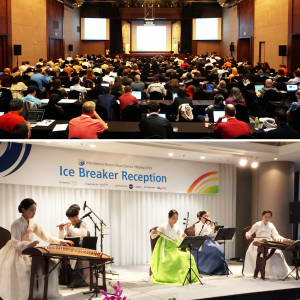 Over 250 ocean colour research scientists and representatives from national space agencies around the world gathered in Busan, South Korea for the very successful 2019 International Ocean Colour Science (IOCS-2019) meeting (9-12 April 2019). We thank our host, the Korea Institute of Ocean Science & Technology (KIOST), for doing such an excellent job in organizing and sponsoring the event, and also the other meeting sponsors NASA, EUMETSAT and Airbus. The Ice Breaker Reception with the Yulparan ensemble playing traditional Korean instruments was certainly one of the highlights of the meeting. We also thank the Scientific Planning Committee for their help in structuring the meeting. The overall goal of IOCS-2019 was to improve communication between research scientists and space agency representatives, and to advance ocean colour radiometry research.
Over 250 ocean colour research scientists and representatives from national space agencies around the world gathered in Busan, South Korea for the very successful 2019 International Ocean Colour Science (IOCS-2019) meeting (9-12 April 2019). We thank our host, the Korea Institute of Ocean Science & Technology (KIOST), for doing such an excellent job in organizing and sponsoring the event, and also the other meeting sponsors NASA, EUMETSAT and Airbus. The Ice Breaker Reception with the Yulparan ensemble playing traditional Korean instruments was certainly one of the highlights of the meeting. We also thank the Scientific Planning Committee for their help in structuring the meeting. The overall goal of IOCS-2019 was to improve communication between research scientists and space agency representatives, and to advance ocean colour radiometry research.
Keynote speakers informed participants about cutting edge research while agency members presented their mission plans as well as emerging applications and science. Nine informative breakout workshops collectively agreed upon requirements for sustained OC research and operations, focussing on the impact of new research avenues and providing advice for future action. Four poster sessions, including two poster lightning sessions, allowed participants to present their own research and converse with professional colleagues. The meeting was preceded by the NASA Ocean Color Research Team (OCRT) meeting as well as three training workshops. Presentations and photos from IOCS-2019 are available on the meeting website, including information about the keynote speakers, breakout workshops, poster abstracts and training workshops. A synthesis of the recommendations from the nine breakout workshops will be published shortly in the Proceedings of the 2019 International Ocean Colour Science Meeting, together with the abstracts from the keynote speakers and agency presentations.
At the recent IOCCG-24 Committee meeting, members pointed out that two years was not enough time in between IOCS meetings for the space agencies, the IOCCG, and the ocean colour community to act upon recommendations from the breakout workshops. For this reason, it was recommended that the next IOCS meeting (scheduled to take place in North America), should take place in four years time, around May 2023, although this decision has not yet been finalized, and feedback is welcomed. Further information will be provided in the coming months.
IOCCG-24 Committee Meeting
 The 24th IOCCG Committee meeting took place at the University of Science & Technology (USTH) in Hanoi, Vietnam from 4-6 April 2019, and was hosted by the Vietnam Academy of Science and Technology (VAST) which is gratefully acknowledged. The meeting was attended by scientific members as well as space representatives from around the world (CONAE, CSA, ESA, EUMETSAT, ISRO, JAXA, KIOST, NASA, NOAA and SIO) who briefed the committee on current and future plans for ocean colour sensors from their respective agencies (some members participated remotely). The Committee reviewed the status of the five current IOCCG working groups which were all making good progress, three of which have almost completed their reports (i.e., the working groups addressing modelling, HABs and uncertainties). Other items discussed at the meeting included a suggestion to establish a new IOCCG Task Force on “Ocean colour hyperspectral remote sensing”, a proposal for a new working group on “Nomenclature”, a new training course to take place in Hangzhou, China in October 2019 (see below), the next “Summer Lecture Series” planned for July 2020, and a journal special issue on “Aquatic Carbon from Space”. Further details of all these initiatives will follow soon. The minutes of the IOCCG-24 meeting will soon be posted here.
The 24th IOCCG Committee meeting took place at the University of Science & Technology (USTH) in Hanoi, Vietnam from 4-6 April 2019, and was hosted by the Vietnam Academy of Science and Technology (VAST) which is gratefully acknowledged. The meeting was attended by scientific members as well as space representatives from around the world (CONAE, CSA, ESA, EUMETSAT, ISRO, JAXA, KIOST, NASA, NOAA and SIO) who briefed the committee on current and future plans for ocean colour sensors from their respective agencies (some members participated remotely). The Committee reviewed the status of the five current IOCCG working groups which were all making good progress, three of which have almost completed their reports (i.e., the working groups addressing modelling, HABs and uncertainties). Other items discussed at the meeting included a suggestion to establish a new IOCCG Task Force on “Ocean colour hyperspectral remote sensing”, a proposal for a new working group on “Nomenclature”, a new training course to take place in Hangzhou, China in October 2019 (see below), the next “Summer Lecture Series” planned for July 2020, and a journal special issue on “Aquatic Carbon from Space”. Further details of all these initiatives will follow soon. The minutes of the IOCCG-24 meeting will soon be posted here.
New IOCCG Committee Members
As an Affiliated Program of SCOR, IOCCG is required to implement a regular rotation of scientific committee members. Accordingly, Lia Santoleri (ISAC–CNR, Italy), Emmanuel Boss (Univ. Maine, USA) and Hubert Loisel (LOG, France) were scheduled to rotate off the Committee. New IOCCG Committee members for 2019 include Claudia Giardino (CNR-IREA, Italy), Aurea Ciotti (Universidade de São Paulo, Brazil) and Vittorio Brando (CNR-ISMAR, Italy). Emmanuel Boss and Hubert Loisel were invited to serve a second term.
Regarding the IOCCG Executive Committee, the following changes were implemented by the various space agencies: Menghua Wang (NOAA/NESDIS/STAR, USA) replaced Paul DiGiacomo, Joo-Hyung Ryu (KIOST, South Korea) replaced Young-Je Park, Marie-Hélène Rio (ESA ESRIN) replaced Craig Donlon (ESA-ESTEC), Frédéric Mélin (EC-JRC) replaced Mark Dowell, Laurent Giugni (CSA, Canada) replaced Martin Bergeron and Xianqiang He (SIO, SOA, China) was invited to serve on the IOCCG Executive Committee. We thank all the outgoing members for their hard work and contributions over the past few years and extend a warm welcome to all our new IOCCG Committee members. The next IOCCG Committee meeting is scheduled to take place in Tokyo, Japan (~23-27 March 2020) hosted by the Japan Aerospace Exploration Agency (JAXA).
Training Course in China
 An advanced training course on ocean colour remote sensing will be held in Hangzhou, China from 24-31 October 2019 to promote satellite ocean colour data applications. This training event is sponsored by IOCCG, EUMETSAT, the State Key Laboratory of Satellite Ocean Environment Dynamics (SOED/SIO/MNR, China), the National Satellite Ocean Application Service (NSOAS, China), and Zhejiang University (ZJU, China). The key objective of this training is to help early career scientists to download, analyze and visualize data from the EUMETSAT Copernicus Marine Data Stream as well as the Chinese HY-1C ocean colour mission. Participants will also learn how to use the “Marine Satellite Data Online Analysis Platform (SatCO2)” for environmental monitoring and scientific research, including water quality monitoring, red tide detection, and marine carbon cycling/climate change investigations. See the IOCCG website at http://ioccg.org/what-we-do/training-and-education/ioccg-2019-hangzhou/ for further information and details on how to apply.
An advanced training course on ocean colour remote sensing will be held in Hangzhou, China from 24-31 October 2019 to promote satellite ocean colour data applications. This training event is sponsored by IOCCG, EUMETSAT, the State Key Laboratory of Satellite Ocean Environment Dynamics (SOED/SIO/MNR, China), the National Satellite Ocean Application Service (NSOAS, China), and Zhejiang University (ZJU, China). The key objective of this training is to help early career scientists to download, analyze and visualize data from the EUMETSAT Copernicus Marine Data Stream as well as the Chinese HY-1C ocean colour mission. Participants will also learn how to use the “Marine Satellite Data Online Analysis Platform (SatCO2)” for environmental monitoring and scientific research, including water quality monitoring, red tide detection, and marine carbon cycling/climate change investigations. See the IOCCG website at http://ioccg.org/what-we-do/training-and-education/ioccg-2019-hangzhou/ for further information and details on how to apply.
IOCCG Protocol Series
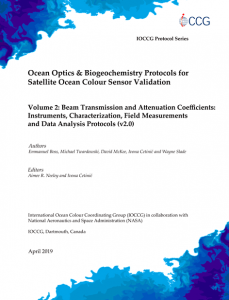 The second volume in the IOCCG Protocol Series entitled “Beam Transmission and Attenuation Coefficients: Instruments, Characterization, Field Measurements and Data Analysis Protocols” (Volume 2.0, April 2019) is now available for download on the IOCCG website. This volume is an update of Chapter 2 in Ocean Optics Protocols for Satellite Ocean Color Sensor Validation Revision 4, Volume IV (Pegau et al. 2003), and serves as a comprehensive overview of beam transmittance concepts and the calibration, measurement and analysis protocols for the state-of-the-art technologies that measure the attenuation of dissolved and particulate matter in water. It includes a detailed overview of measurement concepts and governing equations to derive the beam attenuation coefficient, and details the design, characterization and calibration of beam transmissometers as well as detailed data collection and analysis methods.
The second volume in the IOCCG Protocol Series entitled “Beam Transmission and Attenuation Coefficients: Instruments, Characterization, Field Measurements and Data Analysis Protocols” (Volume 2.0, April 2019) is now available for download on the IOCCG website. This volume is an update of Chapter 2 in Ocean Optics Protocols for Satellite Ocean Color Sensor Validation Revision 4, Volume IV (Pegau et al. 2003), and serves as a comprehensive overview of beam transmittance concepts and the calibration, measurement and analysis protocols for the state-of-the-art technologies that measure the attenuation of dissolved and particulate matter in water. It includes a detailed overview of measurement concepts and governing equations to derive the beam attenuation coefficient, and details the design, characterization and calibration of beam transmissometers as well as detailed data collection and analysis methods.
Introduction to Ocean Colour Science (Chinese)
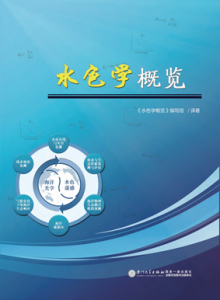 Dr. Zhongping Lee (U. Mass Boston) and colleagues (Yan Bai, Tingwei Cui, Lian Feng, Chengfeng Le, Xiaoju Pan, Shaoling Shang, Junwu Tang, Xiaogang Xing, Peng Xiu, and Yunlin Zhang) have been hard at work preparing an “Introduction of Ocean Colour Sciences” in the Chinese language. This document consists of translations of certain chapters of IOCCG Report 7 (Why Ocean Colour? The Societal Benefits of Ocean- Colour Technology), as well new material. The outline of the various Chinese chapters is shown below (the numbers in parentheses relate to the original chapters in IOCCG Report 7).
Dr. Zhongping Lee (U. Mass Boston) and colleagues (Yan Bai, Tingwei Cui, Lian Feng, Chengfeng Le, Xiaoju Pan, Shaoling Shang, Junwu Tang, Xiaogang Xing, Peng Xiu, and Yunlin Zhang) have been hard at work preparing an “Introduction of Ocean Colour Sciences” in the Chinese language. This document consists of translations of certain chapters of IOCCG Report 7 (Why Ocean Colour? The Societal Benefits of Ocean- Colour Technology), as well new material. The outline of the various Chinese chapters is shown below (the numbers in parentheses relate to the original chapters in IOCCG Report 7).
- Overall introduction of ocean colour science (Ch. 1 and Ch. 2)
- Basic parameters of ocean colour science
- Ocean colour science and biological oceanography
- Ocean colour science and chemical oceanography
- Ocean colour science and water quality monitoring (Ch. 7)
- Ocean colour science and environmental hazards (Ch. 9)
- Ocean colour science and shallow-water environment
- Ocean colour science and ecosystem and fishery (Ch. 6 and Ch. 8)
- Ocean colour science and carbon cycle (Ch. 5)
- Ocean colour science and dynamic ocean and forecast (Ch. 3 and Ch. 4)
- Ocean colour science and climate change (Ch. 10)
- Future perspectives (Ch. 11)
The Chinese report can be downloaded from the IOCCG website at: http://ioccg.org/wp-content/uploads/2019/05/oceancolorsciences_chinese-zp-lee-april-2019-s.pdf
News from NASA
 The Plankton, Aerosol, Cloud, ocean Ecosystem (PACE) mission Science and Applications Team (SAT) call for proposals is now open. PACE is a NASA Earth-observing satellite mission that will continue and advance observations of global ocean color, ocean biogeochemistry, ocean ecology, aerosols, and clouds in support of Earth system and carbon cycle science, as well as produce data to support a breadth of application areas including harmful algal blooms, fisheries, climate, human health, and water and air quality. The purpose of the solicitation is to formulate a PACE Science and Applications Team for a three-year period, pending NASA budget approval. The PACE mission will include a hyperspectral imaging radiometer and two small, contributed multi-angle polarimeters to maintain a time series of critical climate and Earth system variables. The team will encompass basic and applied research and applications, using data from precursors to the Ocean Color Instrument (OCI) and the two contributed polarimeters, the UMBC HARP2 and Netherlands SRON/Airbus SPEXone. See the link to the solicitation or for more information click here.
The Plankton, Aerosol, Cloud, ocean Ecosystem (PACE) mission Science and Applications Team (SAT) call for proposals is now open. PACE is a NASA Earth-observing satellite mission that will continue and advance observations of global ocean color, ocean biogeochemistry, ocean ecology, aerosols, and clouds in support of Earth system and carbon cycle science, as well as produce data to support a breadth of application areas including harmful algal blooms, fisheries, climate, human health, and water and air quality. The purpose of the solicitation is to formulate a PACE Science and Applications Team for a three-year period, pending NASA budget approval. The PACE mission will include a hyperspectral imaging radiometer and two small, contributed multi-angle polarimeters to maintain a time series of critical climate and Earth system variables. The team will encompass basic and applied research and applications, using data from precursors to the Ocean Color Instrument (OCI) and the two contributed polarimeters, the UMBC HARP2 and Netherlands SRON/Airbus SPEXone. See the link to the solicitation or for more information click here.
International participation is welcome on a no-exchange-of-funds basis. Notices of Intent (encouraged, but not required) are due on 15 May 2019, and proposals are due on 15 July 2019. NASA looks forward to broad participation by the international science communities in the PACE Science and Applications Team.
News from NOAA
The NOAA CoastWatch/OceanWatch/PolarWatch Program (a.k.a., CoastWatch) annual science meeting took place 28 April to 2 May 2019, locally hosted by the CoastWatch Great Lakes Regional Node at the NOAA Great Lakes Environmental Research Laboratory (GLERL) in Ann Arbor, Michigan. Stakeholders in the Great Lakes discussed the use of ocean color remote sensing data products such as chlorophyll and various proxies for water clarity and sediment materials to help understand water quality and aquatic ecology for resource management decisions and recreational uses.
News from NOAA and EUMETSAT
 Registration closes on 15 May for the First International Operational Satellite Oceanography (OSO) Symposium, 18-20 June 2019, Washington DC area (and the optional training day on Monday, 17 June 2019 at the same location). The latest working agenda and more information about logistics will be posted soon here and to the NOAA CoastWatch/OceanWatch website.
Registration closes on 15 May for the First International Operational Satellite Oceanography (OSO) Symposium, 18-20 June 2019, Washington DC area (and the optional training day on Monday, 17 June 2019 at the same location). The latest working agenda and more information about logistics will be posted soon here and to the NOAA CoastWatch/OceanWatch website.
Alliance for Coastal Technologies Hyperspectral Algorithm Round-Robin
The Alliance for Coastal Technologies (ACT) is currently accepting applications to participate in a hyperspectral technology demonstration. This is the first step in a series of ACT Technology Demonstrations to evaluate and advance the utility and application of hyperspectral imagery observing systems for shallow freshwater and coastal aquatic ecosystems. For background, ACT held a workshop in May 2018 on Hyperspectral Imaging of Coastal Waters. The workshop report can be found at http://www.act-us.info/Download/Workshops/2018/Hyperspectral_Workshop_Report.pdf. A prioritized list of recommendations emerged from the workshop, including a list of possible demonstration projects that ACT might undertake. The first of these demonstrations is a processing algorithm round-robin, for which this solicitation is seeking participants.
The workshop found that remote sensing of the coastal zone, especially via hyperspectral imaging, currently lacks standardization. This includes, but is not limited to, sensors, radiometric calibrations, geometric calibrations, geophysical variable choices, field validation, and algorithms. Of course, the specific algorithms chosen for a project depend on the geophysical variables to be retrieved from the remote sensing data, but even within a single application area (e.g., coral reefs, harmful algal blooms (HABs), kelp forests etc.), there are numerous competing approaches. Thus, while hyperspectral remote sensing is taking a step toward routine deployment, it still has one foot firmly planted in the realm of research and development.
 The goal of this demonstration activity is to evaluate capabilities and maturities of different algorithms. Each participant will have access to the same data sets and attempt to achieve the same objective(s). The data sets comprise calibrated hyperspectral imagery and ground/water validation data, airborne or in-water, as collected during any number of recent projects (e.g., CORAL, HyspIRI). Additional data sets have been simulated via radiative transfer modeling (e.g., Hydrolight/Ecolight, MODTRAN, 6S).
The goal of this demonstration activity is to evaluate capabilities and maturities of different algorithms. Each participant will have access to the same data sets and attempt to achieve the same objective(s). The data sets comprise calibrated hyperspectral imagery and ground/water validation data, airborne or in-water, as collected during any number of recent projects (e.g., CORAL, HyspIRI). Additional data sets have been simulated via radiative transfer modeling (e.g., Hydrolight/Ecolight, MODTRAN, 6S).
Participants and ACT will together define broad algorithm objectives, based on ecological and/or physical understanding of the system to be studied. Participants will then implement their algorithms to meet those objectives. Example algorithm objectives might include assessment of water quality and phytoplankton diversity, quantification of coral cover, determination of seagrass leaf area index, and/or minimizing error in atmospheric correction, among others. It is expected that participants will choose to focus on one or a few of the targeted objectives. Participants are welcome to demonstrate capabilities beyond the stated objectives, as well.
Participants may apply as individuals or as teams. This is not a funded activity, and ACT does not expect participants to devote a great deal of time and effort. Rather, the aim is for ACT to provide good quality hyperspectral data that can be processed using existing computing infrastructure with minimal impact to participants’ ongoing programs. This is a demonstration of current capabilities, not a research project.
The round-robin is slated to begin in June 2019, but ACT will be accepting applications until August 31, 2019. This will be followed by an in-person workshop in September 2019, which will serve as a mid-activity check-in for early participants and a kickoff for late-joining participants. A final workshop will be held in late winter or early spring 2020. ACT will cover workshop travel costs for one person from each participating team.
There will be an informational webinar on May 29, 2019 1:00 pm-5:00 pm EDT. For more information, or to sign up for the webinar, please contact Dr. Tom Johengen (tom.johengen@noaa.gov).
Radiative Transfer Model OSOAA
A new version (version 1.6) of the radiative transfer model OSOAA (Ordres Successifs Océan Atmosphere Avancé) is now available online. The OSOAA model is able to simulate the radiance and degree of polarization for an atmosphere-ocean system and for a rough sea surface (see Chami, Lafrance, Fougnie et al., Optics Express, 2015). Note that OSOAA also offers a user-friendly interface.
The OSOAA model can be downloaded at the following new internet link (hosted by French space agency, CNES): https://github.com/CNES/RadiativeTransferCode-OSOAA
Book on “Outstanding Topics in Ocean Optics”
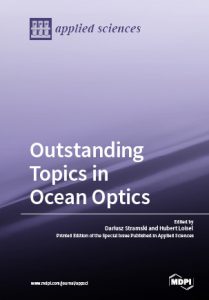 The special issue “Outstanding Topics in Ocean Optics”, edited by Dariusz Stramski and Hubert Loisel, which appeared in December 2018 issue of Applied Sciences, has been printed as a book. The intention of this book is to present a collection of papers that generally share a common denominator of frontier topics in ocean optics, and to provide a balanced view of the extraordinary breadth of research in this field. Topics as diverse as measurements and modelling of radiative transfer, light fields, light scattering and polarization, ocean colour, benthic optical properties, and the use of optics for characterizing seawater constituents are addressed in this book. The book is expected to be of interest and useful to a broad audience of professional ocean scientists, engineers and advanced students with an interest in ocean optics and applications of optical methods in oceanography. The book will be listed in the Directory of Open Access Books (DOAB), Google Books and WorldCat, and is freely accessible on the MDPI Books platform (http://www.mdpi.com/books/pdfview/book/1257). It can be purchased as a printed copy directly from the MDPI website and is also available through distribution platforms such as Amazon.
The special issue “Outstanding Topics in Ocean Optics”, edited by Dariusz Stramski and Hubert Loisel, which appeared in December 2018 issue of Applied Sciences, has been printed as a book. The intention of this book is to present a collection of papers that generally share a common denominator of frontier topics in ocean optics, and to provide a balanced view of the extraordinary breadth of research in this field. Topics as diverse as measurements and modelling of radiative transfer, light fields, light scattering and polarization, ocean colour, benthic optical properties, and the use of optics for characterizing seawater constituents are addressed in this book. The book is expected to be of interest and useful to a broad audience of professional ocean scientists, engineers and advanced students with an interest in ocean optics and applications of optical methods in oceanography. The book will be listed in the Directory of Open Access Books (DOAB), Google Books and WorldCat, and is freely accessible on the MDPI Books platform (http://www.mdpi.com/books/pdfview/book/1257). It can be purchased as a printed copy directly from the MDPI website and is also available through distribution platforms such as Amazon.
New Publications
Two new ocean colour publications from coastal and inlands water have been added to the IOCCG Ocean Colour Bibliography. Ortiz et al. (2019) (Journal of Great Lakes Research) lays out a detailed description of a new methodology, the Kent State University Spectral decomposition method, that is capable of extracting independent spectral signals from optically-complex waters (see figure from the paper below). The method yields independent spectral signals that can be quantitatively related to algal and cyanobacterial classes, suspended sediment minerals and degradation products of photosynthetic pigments, through the use of a spectral library. The eigenvalue-eigenvector decomposition method, varimax-rotated, principal component analysis (VPCA) was applied to four NASA Glenn Research Center, second-generation hyperspectral imager (HSI2) swaths collected over the western basin of Lake Erie within 30 minutes. The method extracted five environmental components and separated the signal from random noise and residual atmospheric errors that remained after atmospheric correction, and demonstrated ±3% reproducibility. In addition, while the HSI2 sensor has a hardware signal to noise ratio (SNR) of 1000:1 in the lab, the VPCA method provided a software improvement to the SNR that range from 7x to 20x, depending on the component. The greatest SNR boost was associated with the smallest variance signals extracted because those were effectively partitioned from the noise and the larger signal, which otherwise swamps them.
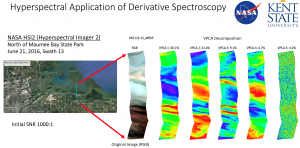
After Ortiz et al., (2019). https://www.sciencedirect.com/science/article/pii/S0380133019300607
A second paper from the same lab (Avouris and Ortiz, JGLR, 2019) validated the VPCA method applied to MODIS images from Lake Erie, documenting reliable retrievals of Chl-a, and consistent multispectral spectral shapes downscaled from hyperspectral ASD FieldSpec HH2 data. These papers document that the VPCA method thus helps to correct atmospheric errors, and to partition image variance into independent components to address the mixed-pixel problem.
Employment Opportunities
Several new positions have been added to Employment Opportunities on the IOCCG website including a data and web services engineer (PML, UK), a software engineer (NASA Goddard) and several post-doctoral opportunities (USA, UK). For more information on these positions see http://ioccg.org/resources/employment-opportunities/

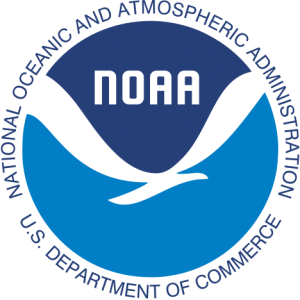

 The sixth International Ocean Colour Science (IOCS) meeting will take place in Darmstadt, Germany from 1 – 4 December 2025, hosted by EUMETSAT and ESA with support from other agencies.
The sixth International Ocean Colour Science (IOCS) meeting will take place in Darmstadt, Germany from 1 – 4 December 2025, hosted by EUMETSAT and ESA with support from other agencies.